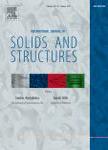版权所有:内蒙古大学图书馆 技术提供:维普资讯• 智图
内蒙古自治区呼和浩特市赛罕区大学西街235号 邮编: 010021

作者机构:Zhejiang Univ Technol Coll Mech Engn Hangzhou 310014 Zhejiang Peoples R China
出 版 物:《INTERNATIONAL JOURNAL OF SOLIDS AND STRUCTURES》 (国际固体与结构杂志)
年 卷 期:2014年第51卷第13期
页 面:2400-2410页
核心收录:
学科分类:08[工学] 0801[工学-力学(可授工学、理学学位)] 080102[工学-固体力学]
基 金:National Natural Science Foundation of China [51005208, 51375448, 51175469] Qianjiang Talent project of Zhejiang province
主 题:Cohesive zone model Inverse analysis Kalman filter algorithm Genetic algorithm Weight-estimating scheme
摘 要:Inverse analysis is widely applied to the identification of material properties or model parameters. In order to improve the computational efficiency of the inverse method based on the genetic algorithm, an interpolation scheme upon the response surface constructed by the finite element simulation has been adopted in this paper. Meanwhile, a gradual homogenization treatment scheme has also been presented to improve the convergence of the inverse method based on the Kalman filter algorithm. Both methods are proven effective in dealing with the single-objective inverse problem. However, literature studies show that the adoption of multiple types of experimental information is useful to improve the accuracy of inverse analysis. In this case, it turns into a multiple-objective inverse problem. Our practice proved that the above-mentioned two methods might not yield a proper result if the sensitivity issue of different types of information is not considered. Therefore, another multi-objective inverse method, in combination of the above two optimization algorithms and a weight-estimating scheme that can consider such sensitivity, has been further presented. Finally, by using a mixed-mode crack propagation simulation and two types of experimental information (loading-displacement response curve and crack path profile), the parameters of the cohesive zone model were inversely identified and its simulation results are in good agreement with the experiment. (C) 2014 Elsevier Ltd. All rights reserved.